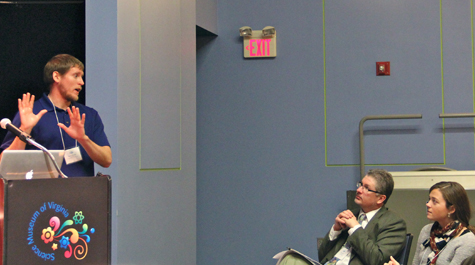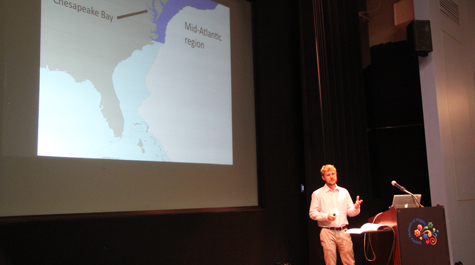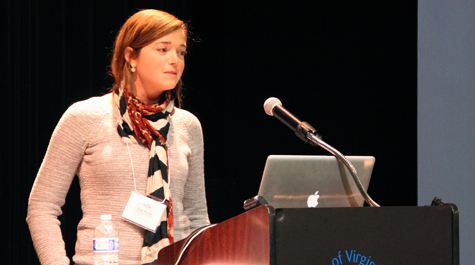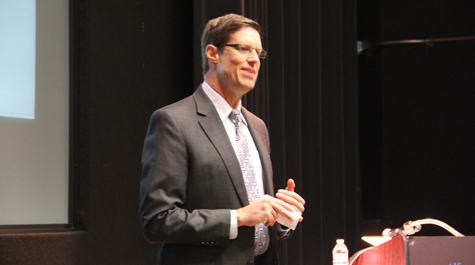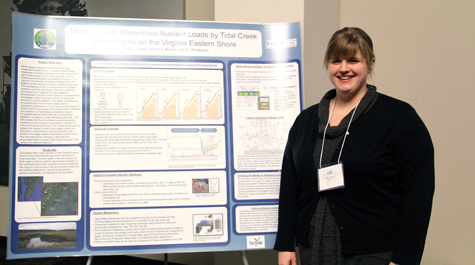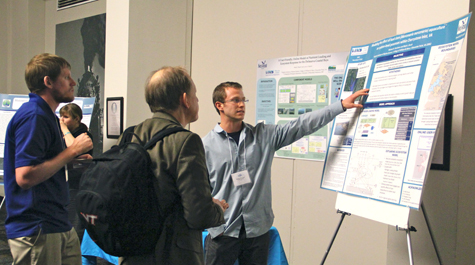VIMS students network, present research at Sea Grant Symposium
Graduate students from the Virginia Institute of Marine Science traveled to the state capital last week to present their research at Virginia Sea Grant’s 5th Annual Project Participants’ Symposium at the Science Museum of Virginia.
During the daylong event, VIMS Ph.D. students Annie Murphy, Ryan Schloesser, and Mark Stratton shared results from their studies of shellfish and finfish in the waters of Chesapeake Bay and coastal Virginia. The trio are fellows in VASG’s Graduate Research Fellowship Program, which helps fund the research of several students in William & Mary’s School of Marine Science at VIMS.
“The research presentations given by the fellows highlight the valuable coastal and marine research VASG continually supports,” says VASG Director Troy Hartley. “The symposium also gives these talented graduate students an opportunity to present their science to an audience of people outside their respective fields.”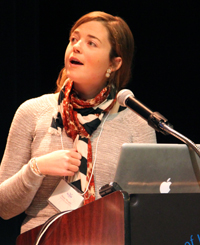
Murphy kicked off the student presentations with an explanation of her thesis work looking at the sustainability of clam aquaculture on the Eastern Shore of Virginia. “The symposium provides a unique opportunity to communicate my research to people involved in industry, advisory service, and regulatory and funding agencies, which reinforces that my research is applicable to the needs of end-users such as the shellfish industry,” she says.
Schloesser presented his research on the condition of juvenile fishes—specifically croaker and flounder—in Virginia estuaries, followed by Stratton’s presentation on his efforts to improve fisheries management by incorporating new environmental and biological information into the assessment of fish stocks.
“I enjoyed listening to the other fellows give their talks so I could see how they approached the challenge of communicating their research in a simple and understandable manner,” says Murphy. “The symposium is important for us because it gives us a chance to communicate our research in a traditional format, but to a different audience compared to who we would speak to at a typical scientific conference,” adds Stratton.
Attendees at the VASG symposium included representatives from Virginia Tech, the University of Virginia, the National Weather Service, the Department of Health, members of the shellfish and fishing industries, and many other institutions.
Each year, VASG selects a keynote speaker to address the audience and help them see the world differently than they do in their day-to-day disciplines, organizations, and tasks. “This year,” says Hartley, “we invited Chief Meteorologist Jeff Lawson with WVEC 13 News in Hampton Roads to provide a window into the world of communicating complicated information to a distracted, yet demanding public.”
During his talk, Lawson discussed how he communicates weather information in an easy to understand, down-to-earth fashion, all while working on the fly in what can be severe-weather situations.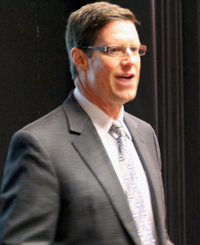
“Nature and its effects are so complex, and can be difficult for the public to understand,” says Lawson. “It’s important that everyone—from researchers, to scientists, to communicators—be on the same page as much as possible.”
Lawson and marine scientists are often faced with similar challenges, in that they are tasked with explaining their work to an audience of non-experts in an understandable way.
“I wanted the audience to benefit from hearing some of the issues we, as TV communicators, have in translating science to an audience in a way they can understand,” says Lawson.
“It’s always challenging to present my research in a matter of minutes, and even more challenging when the audience is not familiar with the background information,” says Murphy. “Presenting data to this audience allowed me to step back and really think about the motivation of my research and try to stress the importance of what I study to the audience.”
Stratton says he also found it challenging to present his research to a more general audience. “It was a little intimidating beforehand, but I had fun answering questions from the audience and it was gratifying afterward.”
Murphy, Schloesser, and Stratton were selected as VASG fellows based on academic achievement, relevance of their research to VASG goals, and demonstrated interest in outreach activities. The research presented at the symposium highlights coastal and marine studies that are equally important to scientists, resource managers, industry, and other stakeholders.
Hartley says the symposium is valuable because it initiates conversations that foster integration across VASG’s several functions, which include research, extension, education, and communication.
“The diversity of backgrounds of attendees at the symposium is very impressive, and I think the VASG staff has been extremely successful at creating an event that gives everyone a chance to make contacts they otherwise wouldn’t have the chance to make,” says Stratton.
More information about the symposium and Virginia Sea Grant is available at http://vaseagrant.vims.edu.


